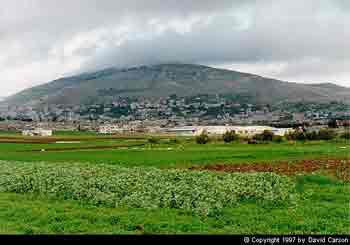Nablus (Shechem)
Nablus, known as the site of biblical Shechem, is one of the largest Palestinian cities with a population of more than 50,000 people. The area of Biblical Shechem can be found in the Balata neighborhood in the south-eastern section of the city. Historically, Abraham traveled through Shechem on his way to Canaan and here offered his first sacrifice to G-d. After the conquest of Canaan, Joshua assembled the Israelites here and encouraged them to follow the Mosaic laws. During the period of the Judges, Abimelech was crowned king here. Biblical Shechem was destroyed by the Assyrians in the 8th century BCE. Inside the area known as Biblical Shechem are the remains of a defensive wall, a 3,600-year-old Hyksos temple and Joseph’s Tomb. During an outbreak of violence in October 2000, Palestinian rioters destroyed Joseph’s Tomb, looting the insides and destroying the Jewish artifacts found inside. Though mostly now in ruins, the IDF semi-regularly coordinates visits to the site for prayer services. Another site related to the biblical patriarch is Jacob’s well, found inside a Greek Orthodox monastery. This site is also holy for Christians who believe Jesus spoke here to a Samaritan woman. Mount Gerizim is another place considered holy by the Jews and the Samaritans. A Samaritan temple was built on Mount Gerizim in the 4th century BCE. At the end the second century BCE, the temple was destroyed by Yohanan Hyrcanos I and was converted into a Temple to Zeus by Antiochus II in 170 BCE. In 484, the site changed hands again, this time to the Byzantine emperor Zenon, who built a church on the site. Today, only 600 Samaritans remain and about half live in Nablus and the other half live in Holon, near Tel Aviv. Every year the Samaritans continue to make an annual Passover sacrifice on Mount Gerizim. West of Mount Gerizim, is the Samaritan quarter. Inside the quarter, there is a synagogue that contains Samaritan Torah scrolls believed to date back to the 13th year of settlement of the Israelites in Canaan. The modern city of Nablus derived its name from a Roman town that was founded in 72 CE, which was close to the biblical city of Shechem. Originally the town was known as Flavia Neopolis, but it was eventually shortened into Nablus, after the Arab conquest in 636 CE. During the period of the Crusader rule, in the 12th century, Nablus was renamed Naples. A palace and citadel were built by the Crusaders and it became the second most important city in the kingdom. Inside the city of Nablus, at the entrance to the casbah, the traditional city center, there are the remains of an amphitheater built in the 3rd century CE, when Nablus was a Roman city. Near Nablus’s market is a tower erected in 1902 by the Turkish Sultan Abdul Hamid, a house used by the Turkish governor and the main mosque. It times of unrest in the region, Nablus is often a focal point of protests and not safe for visitors. |
| Previous | Next |




